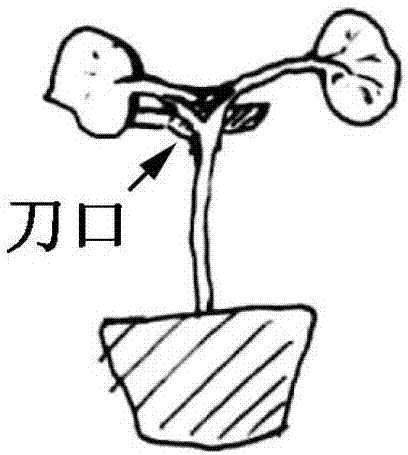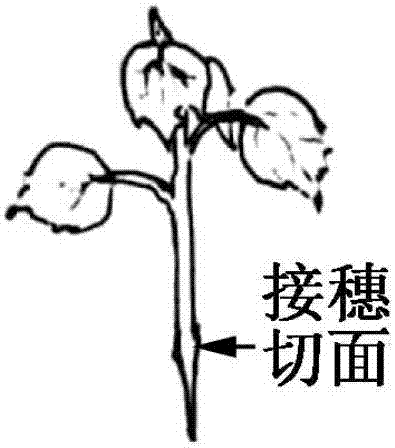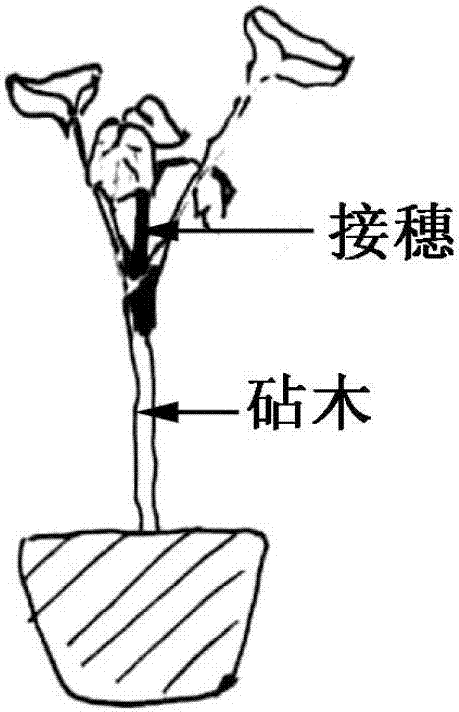Efficient cleft grafting method of dicotyledon seedlings and young branches
A technology of dicotyledonous plants and young shoots, applied in the field of agriculture, can solve the problems of inconvenient rootstock leaf scion nutrition, difficulty of scion insertion and fixation, and pending establishment, etc., to achieve the effect of promoting rapid healing, wide application range, and fast grafting speed
- Summary
- Abstract
- Description
- Claims
- Application Information
AI Technical Summary
Problems solved by technology
Method used
Image
Examples
Embodiment 1
[0033] Embodiment 1. Grafting transgenic regenerated cotton plants on sea-island cotton with 1 to 2 true leaves
[0034] At the end of autumn, winter and spring, the temperature of the greenhouse is more suitable. Graft directly in the greenhouse, and the optimum temperature of the greenhouse is controlled at 28°C±1°C; in summer and early autumn, the temperature is higher, and the grafting is carried out in 50% of the awning.
[0035] Rootstock: Potted cotton cultivar Sea Island cotton seedlings in 20 pots, 5 plants in each pot, a total of 100 plants, after the cotyledons are fully expanded, transplanted into plastic pots with a diameter of about 20 cm, one plant in each pot, as a rootstock.
[0036] Scion: Aseptic transgenic cotton seedlings were cultured as scion.
[0037] Step1: The day before grafting, water the sea-island cotton (cotton seedlings with 1 to 2 true leaves and 2 intact cotyledons) planted in flower pots, keep only 2 cotyledons of the rootstock, and paste the...
Embodiment 2
[0044] Embodiment 2. Grafting transgenic regenerated cotton plants on sea-island cotton with 4 to 6 true leaves
[0045] Rootstock: Potted cotton cultivar Sea Island cotton seedlings in 20 pots, 5 plants in each pot, a total of 100 plants, after the cotyledons are fully expanded, transplanted into plastic pots with a diameter of about 20 cm, one plant in each pot, as a rootstock.
[0046] Scion: Aseptic transgenic cotton seedlings in culture medium are used as scion.
[0047]Step1: The day before grafting, water the sea-island cotton (cotton seedlings with 4 to 6 true leaves) planted in the flower pot with sufficient water, keep 2 cotyledons and 1 to 2 true leaves of the rootstock, and use a sharp The blade cuts off the upper stem and leaf, and then starts from the 5mm lower edge of the petiole of the true leaf, and cuts the stem and the lower edge of the petiole longitudinally from the middle along the central axis of the stem. The incision is neat and smooth, and the incisio...
Embodiment 3
[0054] Embodiment 3, grafting cucumber seedlings on the black-seeded pumpkin with 1 to 2 true leaves
[0055] In early spring, sow 100 pots of black-seeded pumpkin and 100 cucumbers in nutrient bowls, 2 to 3 plants in each pot. When the cotyledons are fully unfolded, leave 1 stronger plant in each pot.
[0056] Rootstock: When the pumpkin seedling grows 1-2 true leaves, and the first true leaf is about 1 cm long, it can be used as a rootstock.
[0057] Scion: 10 days after sowing, the cotyledons of cucumber seedlings will flatten out, and a true leaf and growth point will grow, which can be used as a scion.
[0058] Step1: On the day before grafting, water the pumpkin seedlings (seedlings with 1 to 2 true leaves and 2 intact cotyledons) planted in the nutrient pot with sufficient water, keep only 2 cotyledons of the rootstock, and paste them with a sharp blade. Cut off the stem and leaves above the cotyledon petiole, and then start from the lower edge of the cotyledon petiole...
PUM
 Login to View More
Login to View More Abstract
Description
Claims
Application Information
 Login to View More
Login to View More - R&D
- Intellectual Property
- Life Sciences
- Materials
- Tech Scout
- Unparalleled Data Quality
- Higher Quality Content
- 60% Fewer Hallucinations
Browse by: Latest US Patents, China's latest patents, Technical Efficacy Thesaurus, Application Domain, Technology Topic, Popular Technical Reports.
© 2025 PatSnap. All rights reserved.Legal|Privacy policy|Modern Slavery Act Transparency Statement|Sitemap|About US| Contact US: help@patsnap.com



